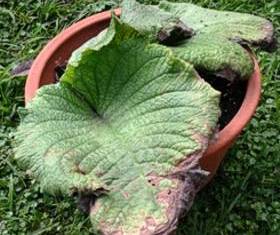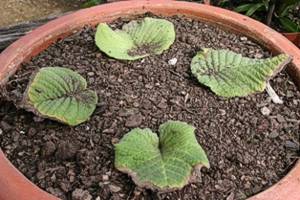Streptocarpus cooksonii
Streptocarpus cooksonii B.L.Burtt.
Family: Gesneriaceae
Common names:
Introduction
Unlike most other Streptocarpus species, this spectacular plant seems to enjoy the heat and strong light conditions found in the Tugela and Buffalo Rivers in KwaZulu-Natal.

Description
Description
An unusual feature of all Streptocarpus species is that each leaf is actually an individual plant with its own roots and flowering stems. Streptocarpus cooksonii is one of the single large-leaved plants that grow over two or more years, flower, set seed and then die (monocarpic). The leaf has a thick texture and is somewhat grey in colour. The crowded, branched inflorescences bear beautiful violet and white-streaked flowers. The long fruit capsules twist open in a spiral when dry, releasing lots of very small, light seeds. Flowering time: the height of summer.

Conservation Status
Status
Streptocarpus cooksonii, although not common, is not listed as threatened.
Distribution and habitat
Distribution description
Streptocarpus cooksonii is confined to central KwaZulu-Natal and more especially the hot, dry valleys leading to the Tugela and Buffalo Rivers. It is found in the shelter of rocky outcrops in open grassland where it often receives direct sunlight. Burtt & Hilliard (1971) record an old prospector remarking on 'a lovely magenta and white Streptocarpus growing in the crevices of pudding stone boulders in the Buffalo River valley where even candles fall flat in summer'.
Derivation of name and historical aspects
History
The name Streptocarpus is derived from the Greek word streptos and refers to the spirally twisted seed pod. Streptocarpus belongs to the same family, Gesneriaceae, as the well-known African violets (Saintpaulia) and gloxinias (Sinningia) that are grown as potplants all over the world. This is a large family of mostly tropical and subtropical herbs, with ± 130 genera, and ± 2900 species world-wide. There are eight genera in Africa, with the one genus, Streptocarpus, represented in South Africa by ± 51 species. The family is named after Konrad Gesner, a Swiss scholar.
Ecology
Ecology
In South Africa there are two main growth forms: plants with a single large leaf (monocarpic) which flower, set seed and die; and species which have numerous rough, hairy leaves that grow in a rosulate formation on a stout horizontal rhizomatous rootstock-each leaf has its own roots and flowers and these plants can grow for a number of years (plurifoliate).
Uses
Use
Some species of Streptocarpus are used in Zulu medicine where leaf infusions are drunk to ease birth pains.
Streptocarpus hybrids are very popular indoor potplants, particularly overseas. It is interesting to note that only a few species were used as parent plants in order to develop the hybrids available today and with such great variation within species which easily hybridize, there is still much scope to develop completely new hybrids. In Europe and America, Streptocarpus are well known as potplants and a thriving industry has developed with new, exciting hybrids being developed each year as more species are introduced into the breeding programmes.

Growing Streptocarpus cooksonii
Grow
Streptocarpus cooksonii can only be propagated from seed sown during the warm spring and summer months. Carefully scatter the seeds on a moist, well-drained medium and place in a spot with good light but not direct sunlight. Water regularly with a fine spray not allowing the seedlings to dry out. Germination is usually within a month.
Plant the seedlings into small pots only once they are quite big and strong. Transplant into bigger pots when the roots have completely filled the small pots. Remember that it is better to underpot than to overpot
Streptocarpus cooksoniana is a plant that is never seen in gardens due to its unavailability in the trade and because it can be difficult to grow in home garden conditions. The unusual purple colour of the flowers and large grey leaves make it a must for those adventurous gardeners who thrive on challenges. It grows well as a pot plant in the KwaZulu-Natal Botanical Garden in the polycarbonate covered seed house where it is kept dry in strong light conditions. Good ventilation is essential to prevent the plants from rotting. Grow the plants in a commercially available composted pine bark medium and feed are regularly with liquid foliar feed during the growing season. Repot once the plant's roots appear at the bottom of the pot.
References
- Batten, A. 1986. Flowers of southern Africa. Frandson Publishers, Sandton, Johannesburg.
- Burtt, B.L. & Hilliard, O.M.. 1971. Streptocarpus, an African plant study. University of Natal Press, Pietermaritzburg.
- Hutchings, A. 1996. Zulu medicinal plants. An inventory. University of Natal Press, Pietermaritzburg.
- Leistner, O.A. (ed.). 2000. Seeds plants of southern Africa : families and genera. Strelitzia 10. National Botanical Institute, Pretoria.
- Pooley, E. 1998. A field guide to wild flowers of KwaZulu-Natal and the Eastern Region. Natal Flora Publications Trust, Durban.
Credits
Brian Tarr
Kwa Zulu-Natal National Botanical Garden
November 2008
Plant Attributes:
Plant Type: Perennial
SA Distribution: KwaZulu-Natal
Soil type: Loam
Flowering season: Early Summer, Late Summer
PH: Neutral
Flower colour: Purple, White
Aspect: Full Sun, Morning Sun (Semi Shade), Afternoon Sun (Semi Shade)
Gardening skill: Challenging
Special Features:
Horticultural zones







Rate this article
Article well written and informative
Rate this plant
Is this an interesting plant?
Login to add your Comment
Back to topNot registered yet? Click here to register.